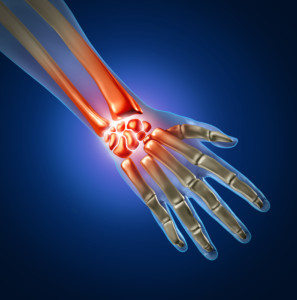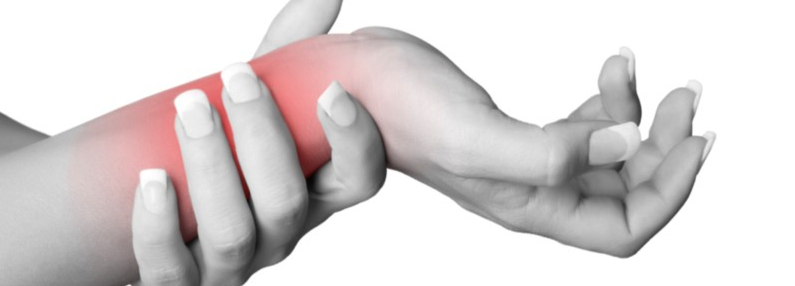Anatomy of the Carpal Tunnel
The carpal tunnel is actually a hollow tunnel or space within the human wrist that allows a complex series of muscles, tendons (flexor tendons) and nerves (most specifically, the median nerve, or large nerve that runs through the middle) to connect the intricate bones of the fingers to the hands and wrist.
With carpal tunnel syndrome, one particular ligament – the transverse carpal ligament –pressure on the median nerve. The median nerve runs through the carpal tunnel to nine flexor tendons that enable your hand and fingers to move.
The flexor tendons have a special lubricated membrane that allows for smooth, frictionless movement as they glide back and forth through the tunnel.
The transverse carpal ligament is a strong, wide band of ligament that goes over the tunnel, from one side of the wrist to the other. Think of it like a little “tent” over the tunnel. In carpal tunnel syndrome, the tendons become swollen, and the soft walls of the median nerve are compressed. No longer are the tendons able to glide smoothly through the tunnel, and in the middle is the median nerve, squeezed by the swollen tendons.
Call (602) 507 – 6550 to schedule your Appointment TODAY!

Causes of Carpal Tunnel Syndrome
There are many causes, some unknown, for carpal tunnel, and is becoming increasingly more common. The most widely-seen cause is repetitive movements, particularly with the wrists down, like when typing on a keyboard. Companies now often take careful steps to ensure that their workers have proper ergonomics, whether that’s a keyboard wrist wrest, wrist braces, proper chairs and desks, etc.

Those with diabetes have a higher incidence of carpal tunnel syndrome.
However, many do not practice good ergonomics at home, particularly with the growing popularity of laptops. Ergonomic concerns are not just limited to a computer office space or keyboard. Workers who use power tools repetitively, or gardening equipment, or who paint as well as participate in many other occupations and hobbies are at risk for carpal tunnel syndrome.
Other causes are medical in nature, either in association with other diseases and disorders or by hereditary factors. For example, sometimes pregnancy can cause carpal tunnel, with swollen wrists that may occur with water retention.
Diabetes and rheumatoid arthritis are two other common diseases that may result in carpal tunnel syndrome. Some other disorders that may attribute to onset of carpal tunnel syndrome are: thyroid or pituitary gland disorders, menopause, vitamin deficiency and physical injury.
Symptoms of Carpal Tunnel Syndrome
The beginning symptoms of carpal tunnel syndrome are usually a slight tingling or burning sensation in the hands, wrists or fingers. The hand or wrist might feel unusually fatigued,  almost as if it were falling asleep.
almost as if it were falling asleep.
Over time, the symptoms will gradually increase, where shooting nerve pain, numbness, temperature sensitivities and loss of movement become more severe. In unusual circumstances, pain may travel further up the arm, even to the shoulder.
Swelling often occurs, and the sufferers will find themselves unable to pick up or grasp objects with the same dexterity they once had. If left untreated, it can result in a crippling, constant pain and the potential inability to use the fingers or hand.
Diagnosing Carpal Tunnel Syndrome
A lot of carpal tunnel syndrome diagnosis comes from the history from the patient. Also, there are multiple physical exam techniques that help make the diagnosis, such as the Tinel’s and Phalen’s signs.
Along with the history and physical, an electromyography and nerve conduction velocity (EMG/NCV) test may show the diagnosis as well. It’s not a perfect test, but the combination of the diagnostic methods can typically make the diagnosis.
Treatment Options for Carpal Tunnel Syndrome
The positive news is that carpal tunnel syndrome is fairly easy to treat, although it may take some time. More often than not, an early diagnosis and proper ergonomic care can eliminate the symptoms of carpal tunnel. It’s imperative to seek out a professional, rather than self-diagnose, to ensure there are no other medical issues or problems occurring.
Once the diagnosis has been made, your AZ pain doctor may recommend ice therapy to reduce swelling, a wrist brace, strengthening and mobility exercises to increase blood flow, topical ointments such as capsaicin cream, and NSAIDs for swelling and pain reduction.
Injections into the carpal tunnel with steroid may reduce the inflammation and swelling from the syndrome for months at a time.
Each one of those therapies should provide immediate relief to some degree, and further physical therapy and routine care will help ensure good ergonomic habits and the reversal of the syndrome. In some cases, alternative therapies such as acupuncture and yoga can help alleviate symptoms. Chiropractic care has also provided some relief for carpal tunnel syndrome sufferers.
In the most severe cases, surgery may be necessary. The University of Maryland Medical Center states, “Every year more than 500,000 people in the US undergo surgeries for carpal tunnel syndrome. Surgery for CTS is among the most common hand surgeries. In various trials, 70 – 90% of patients who underwent surgery were free of nighttime pain afterward.” (Simon, Harvey, MD. “Carpal Tunnel Syndrome – Surgery.” Carpal Tunnel Syndrome. University of Maryland Medical Center, 12 May 2009. Web. 17 Dec. 2012.)
While surgery may be the last resort for severe sufferers, as with other surgeries, it’s not without risks and complications. Since this disorder is so effectively treated with  conventional, alternative, non-traditional treatments, most doctors encourage patients to try other methods first.
conventional, alternative, non-traditional treatments, most doctors encourage patients to try other methods first.
Arizona Pain Specialists offers comprehensive nonsurgical treatment for carpal tunnel syndrome. This includes treatment with medications, injections, bracing, chiropractic and physical rehabilitation treatment along with acupuncture.
Call (602) 507 – 6550 to schedule your Appointment TODAY!

![]()




 almost as if it were falling asleep.
almost as if it were falling asleep. conventional, alternative, non-traditional treatments, most doctors encourage patients to try other methods first.
conventional, alternative, non-traditional treatments, most doctors encourage patients to try other methods first.